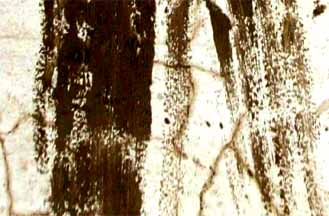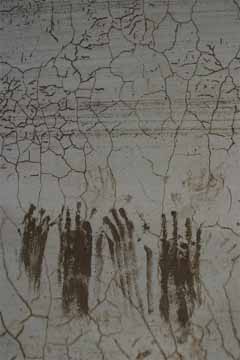The Shalan Flash Flood - Part 2
Little did I imagine that the story (see The Shalan Flash Flood - Part 1) of the hand prints on the wall at the Heilongjiang school would generate a media story. Here is the famous photograph that appeared on the front page of Beijing News:
Here is what commentator Xin Haiguang summarized are the resulting media-related questions:



Is this a done deal then? Not so fast.
Both the reporter and the editor responded immediately with full details about how those photographs were taken and the decision-making process with respect to their publication. There is a whole host of explanations with respect to the points made above. For example, one assumption might been that the kids are tiny, when in fact there are 14-year-old farmers still attending fourth-grade; the reporter had established this point by comparing his own hand size against those of some surviving fourth-graders. But the best explanation comes from the follow-up story by the same reporter, Guo Xianghe, with another accompanying photograph:
Shanghai Morning News (via Sina.com) A Surviving Student Returns To The Scene To Recall The Story Behind The Handprints. By Guo Xianghe. June 15, 2005.
[in translation] Yesterday at about 15:00, 13-year-old fourth year student Zhao Mingxing met our special correspondent as he was leaving his afternoon class at Shalan Town Central Primary School. He spoke of the the flashflood on June 10. He said, "I feel terrible the last few days. Whenever I close my eyes, I can see the faces of the dead classmates ..."
Inside the fourth-year classroom, Zhao pointed to the window and said, "I stood on the ledge and I was able to avoid the flood. But many other classmates were struggling in the water. Then they vanished ..." At the time, only a few students were on the ledge and only a few managed to get close. A couple of other students survived by getting on the window ledge in the corridor. Zhao said that the stood there for more than an hour before the water slowly receded. Afterwards, it was found that 24 died out of a class of 34.
As the water receded, some of the bodies of the classmates appeared. Zhao recalled that some were lying face up and some where face down. Zhao, who did not know much, pushed them and asked: "Are you okay?" But those students who had just spoken to him earlier are now breathless. One student by a table had his mouth wide open out of fear, and it looked terrifying. For the next few days, these scenes replayed themselves in Zhao's mind. So he was very distracted in class. This was the first time that he had been so close to a death scene.
Zhao's best friend in class was named Wang Zhongqi. At 12 years old, Wang was a head shorter than Zhao, but they liked each other and hang around all the time. When the flood water rose, the children stood on their desks. When Zhao saw the water rising rapidly, he jumped over to the window ledge. By that time, the water had toppled over Wang's desk. As Zhao saw his best friend struggle in the water, he wanted to pull him up but he was too far away. As he hesitated, Wang vanished underneath. At that time, the windows broke and the water began to flow outside. After the water receded, they counted the bodies and Wang's body had been washed outside the classroom.
"Will you remember this good primary school classmate when you grow up?" Zhao began to sob: "I am thinking. If there ever was another flood, I would act like a man and jumped into the water to save him at the risk of my own life."
The water came quickly. Within a matter of a few dozen seconds, the desks underneath the children were all toppled over. Children who could not swim fell into the water. The water was muddy and carried a lot of sand, all the fallen children were covered with mud.
Zhao pointed to a handprint on the wall: "I saw 12-year-old Liu Hongda fall into the water. When he rose out of the water, he was covered with mud. He wanted to get up by hanging onto the wall. So he kept pulling at the wall and left two handprints on the wall. Then the water rose over his head, but he kept trying to crawl up the wall with his hands. But he could not get up. Then he disappeared. They have not found his body yet ..."
Why were the handprints on the walls clearly visible after the flashflood? According to the explanation from a People's Liberation Army soldier who participated in the rescue work, the mud at the bottom of the water was very sticky and also denser than the muddy flood water in the upper layers. As the children fell from their desks into the water, the water had already risen to a certain height and then slowly upwards inside the closed room. So there was no eroding action to sweep away the marks. As the water receded slowly, many such handprints were left behind on the walls.
Zhao Mingxing at the spot
where Liu Hongda made the handprints
You can make up your own mind about the authenticity of those photographs. To my mind, the most impressive thing was the manner in which the debate was conducted. There exists a core group of media workers who care passionately about their professional work and who are capable of conducting discourse in a rational and dispassionate manner. The rapid response and full disclosure even compare favorably against how the major western media handle problems. Media in China is more than just a bunch of hacks re-printing Xinhua press releases.